I. Introduction
The Cattle Situation Report presents the industry situation in terms of volume and value of production, inventory by classification, volume and value of imports, and monthly average farmgate and retail prices. It serves as a ready reference for the various clients and stakeholders of the Philippine Statistics Authority (PSA) in the agriculture sector.
The data for this report were collected by PSA through the two surveys, namely, Backyard Livestock and Poultry Survey (BLPS) and the Commercial Livestock and Poultry Survey (CLPS). Both surveys are conducted quarterly in all provinces including National Capital Region (NCR).
The BLPS aims to generate estimates on the supply and disposition of livestock and poultry commodities at the household level. In 2023, the number of sample households covered was 21,783 from the 1,156 sample barangays nationwide. On the other hand, the CLPS seeks to generate estimates on the supply and disposition of livestock and poultry commodities from the sample establishments. There were 213 sample cattle establishments covered in 2023.
The data on the number of cattle slaughtered in slaughterhouses were sourced from the Compilation of Data from Slaughterhouses and Poultry Dressing Plants (CDSPDP), an administrative-based activity of the PSA. This activity covers 1,304 licensed to operate meat establishments (LTOMEs) and Locally Registered Meat Establishments (LRMEs) nationwide. This is undertaken in coordination with the National Meat Inspection Service (NMIS) and the Local Government Units (LGUs).
II. Data Collection
A. Backyard Livestock and Poultry Survey
1. Data collection procedure
The schedule of field data collection is every first seven (7) days of the month after the reference quarter. However, the data collection for fourth quarter is done one month earlier to comply with the Philippine System of National Accounts (PSNA) calendar. The data collection was undertaken by hired Statistical Researchers (SRs) through face-to-face interview with qualified respondents of the sample households. Prior to data collection, training of selected personnel from Field Offices, including SRs, was conducted to ensure uniform understanding of concepts and proper implementation of survey procedures. Field and manual editing of the accomplished questionnaires was done to ensure completeness, consistency, and reasonableness of the information gathered.
2. Survey Questionnaire
The BLPS Questionnaire is a 19-page form composed of 16 blocks that aims to gather information on the basic characteristics and operations of the household.
The data items included in the survey are as follows:
a. Type of household operation/purpose
b. Inventory by age
c. Breeder that gave birth
d. Supply indicator (number of births, received/acquired)
e. Slaughtered in the household
f. Sold live for slaughter
g. Sold live for other purposes (breeding, fattening)
h. Average farmgate price
i. Milk production indicators
j. Deaths/Losses
k. Average liveweight per head
l. Disposition by areas of destination
m. Assessment of household’s production
B. Commercial Livestock and Poultry Survey
1. Data collection procedure
The schedule of field data collection is during the last ten days of the quarter. However, the data collection for the fourth quarter is done one month earlier to comply with the PSNA calendar. The data collection is undertaken by hired SRs and is done through a face-to-face interview with qualified respondents of the farms/establishments. Prior to data collection, training of Field Office personnel, including SRs, was conducted to ensure that the procedures and concepts of the survey are understood and properly implemented. Field and manual editing of the accomplished questionnaires was done to ensure completeness, consistency, and reasonableness of the information gathered.
2. Survey Questionnaire
The CLPS Cattle Survey Questionnaire is a five-page questionnaire that aims to gather necessary information on supply and disposition of cattle commercial farms/establishment.
The data items included in the survey are as follows:
a. Type of establishment operation
b. Inventory by age
c. Supply indicator (number of births, received/acquired)
d. Slaughtered in the establishment
e. Sold live for slaughter
f. Sold live for other purposes (breeding, fattening)
g. Average farmgate price
h. Milk production indicators
i. Deaths/Losses
j. Average liveweight per head
k. Disposition by areas of destination
l. Assessment of establishment’s production
C. Compilation of Data from Slaughterhouses and Poultry Dressing Plants
1. Data collection procedure
The schedule of field data collection is during first ten days of the month and is undertaken by regular Provincial Statistical Office (PSO) personnel. The data is obtained from the administrative records of National Meat Inspection Service (NMIS) and Locally Registered Meat Establishment (LRME) supervised by the Local Government Units (LGUs).
2. Collection Forms
The collection forms used in CDSPDP consists of two (2) forms, namely CDSPDP Form 1a (Livestock) and CDSPDP Form 1b (Poultry). These forms aim to gather information on the number of livestock and poultry commodities slaughtered/dressed in slaughterhouses/poultry dressing plants.
The data items included in the forms are as follows:
a. Number of Heads/Birds
b. Total Carcass/Dressed Weight
III. Sampling Design
A. Backyard Livestock and Poultry Survey
1. Sampling Frame
The BLPS sampling frame is based on the results of the 2017 Listing of Farm Households (LFH) and 2012 Census of Agriculture and Fisheries (CAF). For barangays not covered in the 2017 LFH, the list of households was taken from the 2012 CAF. The sampling frame is updated quarterly based on the status of the sampled households using structured Frame Maintenance Form (FMF) submitted by the PSOs every quarter.
2. Sample Selection Procedure
The BLPS uses two-stage sampling design. The first stage is the selection of sample barangays or Primary Sampling Units (PSUs) using probability proportional to size, where the measure of size is the total animal inventory.
The second stage is the selection of sample households or Secondary Sampling Units (SSUs) that are engaged in livestock and poultry raising in the sampled barangays using systematic sampling.
The number of sample households per selected barangay is 20 but this could be less if the selected barangay has less than 20 households. The sample households per quarter are independent.
The sample size was determined based on a five percent (5%) target coefficient of variation.
3. Domain
The domain of the survey is the province. In the case of NCR, the region is the domain.
4. Estimation Procedure
a. Survey Weight
a.1. Base Weight
PSU Weight
The PSU weight is computed as follows:
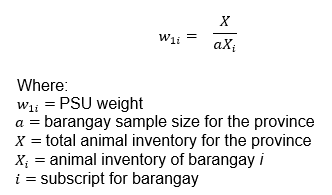
SSU Weight
The SSU weight is computed as follows:
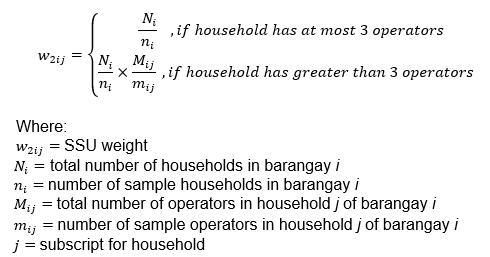
Base Weight
The base weight is the product of the PSU and SSU weights. That is,

a.2. Adjustment Factor
The adjustment factor to account for non-response is given as follows:
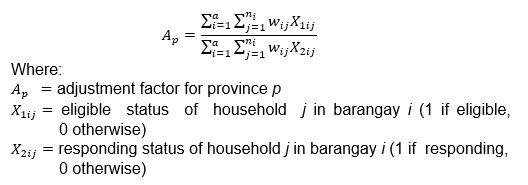
Eligible households are the following:
- Interview completed;
- Refused to be interviewed without replacement;
- Temporarily away/Not at home without replacement; and
- HH temporarily not accessible without replacement.
Ineligible households are the following:
- Resides outside the barangay;
- Unknown in the locality; and
- Deceased (No other livestock and poultry operator in the household).
a.3. Final Weight
The final weight formula is given as follows:
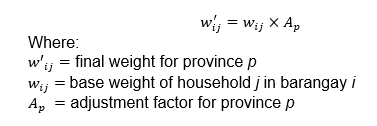
b. Estimation of Total
b.1. Estimation of Provincial Total
b.1.1. Estimation of provincial total is done per animal type and the formula is given as follows:

b.1.2. For the average farmgate price, the provincial estimate is computed by summing up the product of farmgate prices and its corresponding final weight. The result is then divided by the sum of the final weight of all sample households with responses in farmgate price. The formula is given as follows:
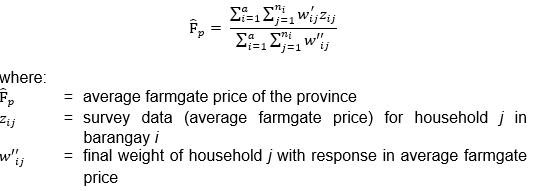
b.2. Estimation of Regional and National Total
b.2.1. The regional estimates are obtained by aggregating the estimates for the provinces within the region, while the national estimate is derived by adding all the regional estimates obtained in each region.
b.2.2. The computation of regional and national farmgate prices is similar with that of the provincial farmgate price.
B. Commercial Livestock and Poultry Survey
1. Sampling Frame
The CLPS frame is based on the results of the 2021 Updating of the List of Establishments (ULE). It is updated quarterly based on the results of visit of the sample establishments using the FMF.
2. Sample Selection Procedure
The CLPS uses stratified probability proportional to size sampling design, where the establishment is the primary sampling unit. The animal type serves as a stratification variable and the size measure is the maximum farm/housing capacity of the establishment. Per animal type, the establishments are sorted by maximum farm/housing capacity and sample establishments are selected using systematic sampling. A panel sample establishment is maintained for a year and a new set of samples is selected during the first quarter of the next year.
Complete Enumeration (CE) is applied for provinces with less than 25 commercial establishments, otherwise, sampling is used.
3. Domain
The domain of the survey is the province. In the case of NCR, the region is the domain.
4. Estimation Procedure
a. Survey Weight
a.1. Base Weight
The base weight per animal type is given as follows:
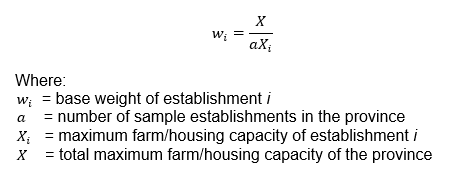
a.2. Adjustment Factor
The adjustment factor to account for non-response is given as follows:

Eligible establishments are the following:
- Operational
- Refusal
- Cannot be contacted/Not accessible
Ineligible establishments are the following:
- Temporarily Stopped Operation
- Permanently Closed/Stopped Operation
- Shifted Farm Operation
- Cannot Be Located
- Duplicate
- Out-of-scope - Recreation
- Out-of-scope - Change Sector
- Out-of-scope - Main Office/Ancillary Unit
a.3. Final Weight
The final weight formula is given as follows:
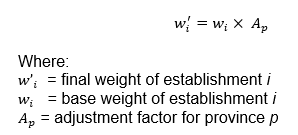
b. Estimation
b.1. Estimation for the Province
b.1.1. Estimation of provincial total is done per animal type and the formula is given as follows:

b.1.2. For the average farmgate price, the provincial estimate is computed by summing up the product of farmgate prices and its corresponding final weight. The result is then divided by the sum of the final weight of all sample establishments with responses in farmgate price. The formula is given as follows:

b.2. Estimation of Regional and National Total
b.2.1. The regional estimates are obtained by aggregating the estimates for the provinces within the region, while the national estimates are derived by adding all the regional estimates obtained in each region.
b.2.2. The computation of regional and national farmgate prices is similar with that of the provincial farmgate price.
IV. Concepts and Definitions of Terms
Farmgate price refers to the price received by raisers for their produce at the location of farm. Thus, the marketing costs, such as the transport and other marketing costs (if any) incurred in selling the produce, are not included in the farmgate prices.
Imports refer to the number of meat products originating from foreign country. The data on meat importation data are compiled by the Trade Statistics Division of PSA from the copies of Import Entry and Internal Revenue Declaration collected from the Bureau of Customs (BOC).
Inventory refers to the actual number of cattle present in the farm as of a specific reference date.
Licensed to Operate Meat Establishment (LTOME) refers to premises/facilities where food animals are slaughtered for human consumption. These were then referred to as accredited slaughterhouses and poultry dressing plants.
Locally Registered Meat Establishment (LRME) refers to slaughterhouses, meat processing plants, Poultry Dressing Plants, meat cutting plants, and cold storages that are allowed to operate by the city/municipal government but are not accredited by the NMIS.
Retail price refers to the prices at which retailers sell their goods or commodities to consumers in the marketplace.
Slaughterhouses (SH) are premises that are approved and registered by the NMIS and LGUs in which food animals are slaughtered for human consumption.
Value at constant price refers to the valuation of transactions, wherein the influence of price change from base year to the current year has been removed.
Value at current price refers to the value based on prices during the reference year; nominal year.
Value of production refers to the value of the animal with reference to its farmgate price. It is derived by multiplying the volume of production by its farmgate price.
Volume of production refers to the number of tended/raised cattle disposed for slaughter including animals shipped-out for slaughter. This is expressed in metric tons, liveweight.
V. Farm Classification
The following are the new farm classifications and definitions based on the approved PSA Board Resolution No. 04, series of 2022:

The data on inventory of cattle based on the definitions indicated above can be accessed in the OpenSTAT website of PSA with the link: https://bit.ly/livestock-inventory-classification
Similarly, data on inventory of cattle by farm type (i.e., backyard and commercial) can still be accessed in the OpenSTAT website of PSA with the link: https://bit.ly/livestock-inventory-farm-type
VI. Dissemination of Results and Revision
The PSA disseminates the Cattle Situation Report annually, every March, with previous year as the reference period. This report is uploaded in the PSA Website.
The livestock and poultry statistics follows the revision policy as stipulated in the PSA Board Resolution No. 1, Series of 2017-119 approving the revision of quarterly estimates on agricultural production, prices, and related statistics to be limited to the immediately preceding quarter and for the past three years with quarterly breakdown to be done only during May of the current year.
VII. Citation
Philippine Statistics Authority. (April 2024). Technical Notes on 2023 Cattle Situation Report. https://bit.ly/cattle-technical-notes
VIII. Contact Information
Precious S. Jacinto
(Officer-In-Charge)
Supervising Statistical Specialist
Livestock and Poultry Statistics Division
Economic Sector Statistics Service
Sectoral Statistics Office
Philippine Statistics Authority
Email Address: p.jacinto@psa.gov.ph
For data request, you may contact the:
Knowledge Management and Communications Division
Telephone: (632) 8462-6600 loc. 839
Email Address: info@psa.gov.ph
